
Koodal Aḻagar Temple in Madurai, a city in the South Indian state of Tamil Nadu, is dedicated to the Hindu god Vishnu. Constructed in the Dravidian style of architecture, the temple is glorified in the Naalayira Divya Prabandham, the early medieval Tamil canon of the Alvar saints from the 6th–9th centuries CE. It is one of the 108 Divya Desams dedicated to Vishnu, who is worshipped as Viyooga Sundarrajan, and his consort Lakshmi as Mathuravalli.
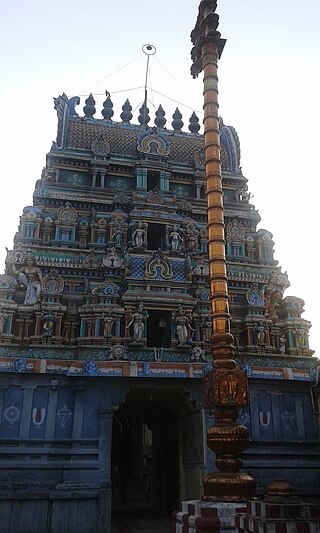
The Devaadi Raja Perumal temple in Therazhundur, a village in Mayiladuthurai district of the South Indian state of Tamil Nadu, is dedicated to the Hindu god Vishnu. Constructed in the Dravidian style of architecture, the temple is glorified in the Naalayira Divya Prabandham, the early medieval Tamil canon of the Alvar saints from the 6th–9th centuries CE. It is one of the 108 Divya Desams dedicated to Vishnu, who is worshipped as Amaruviappan, and his consort Lakshmi as Sengamalavalli Thayar. The original structure of the temple was built by the Karikala Chola during the 1st century CE, with later additions from the Cholas during the 11th century.

Tiruvekkaa Temple or Yathothkari Perumal Temple is a Hindu temple located in Kanchipuram in the South Indian state of Tamil Nadu and dedicated to the Hindu god Vishnu. Constructed in the Dravidian style of architecture, the temple is glorified in the Naalayira Divya Prabandham, the early medieval Tamil canon of the Alvar saints from the 6th–9th centuries CE. It is one of the 108 Divya Desams dedicated to Vishnu, who is worshipped as Yathothkari Perumal, and his consort Lakshmi as Komalavalli.

Sthalasayana Perumal Temple is a Hindu temple dedicated to the god Vishnu located near Kollumangudi, Tamil Nadu, India. It is located 2 km away from Kollumangudi, 40 km away from Kumbakonam and 10 km from Karaikal. Constructed in the Dravidian style of architecture, the temple is glorified in the Nalayira Divya Prabandham, the early medieval Tamil canon of the Alvar saints from the 6th–9th centuries CE. It is one of the 108 Divya Desams dedicated to Vishnu, who is worshipped as Sthalasayana Perumal and his consort Lakshmi as Thirumagal Nachiyar. A granite wall surrounds the temple, enclosing all the shrines. There is a four-tiered rajagopuram, the temple's gateway tower, in the temple.

Nachiyar Kovil or Thirunarayur Nambi Temple is a Hindu temple in Thirunarayur, a village in the outskirts of Kumbakonam in the southern Indian state of Tamil Nadu, is dedicated to the Hindu god Vishnu and his wife Lakshmi. It is the sub urban region of business city of Kumbakonam.
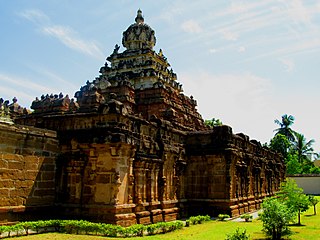
Thiru Parameswara Vinnagaram or Vaikunta Perumal Temple is a Hindu temple dedicated to the God Vishnu, located in Kanchipuram in the Southern Indian state of Tamil Nadu. Constructed in the Dravidian style of architecture, the temple is glorified in the Nalayira Divya Prabandham, the early medieval Tamil canon of the Alvar saints from the 6th through the 9th centuries CE. It is one among the 108 Divya Desams dedicated to the God Vishnu, who is worshipped as Vaikuntanathan and his consort, the Goddess Lakshmi as Sri Vaikundavalli. The temple is considered the second oldest extant temple in Kanchipuram after the Kailasanathar temple.

Tirupavalavannam or Pavalavanam temple located in Kanchipuram in the South Indian state of Tamil Nadu, is dedicated to the Hindu god Vishnu. Constructed in the Dravidian style of architecture, the temple is glorified in the Nalayira Divya Prabandham, the early medieval Tamil canon of the Alvar saints from the 6th–9th centuries CE. It is one of the 108 Divya Desams dedicated to Vishnu, who is worshipped as Pavalavannar Perumal and his consort Lakshmi as Pavalavalli.

Kazheesirama Vinnagaram or Tadalan Kovil or Tiruvikrama (trivikara) Perumal Temple is a temple dedicated to Vishnu located in Sirkazhi, Tamil Nadu, India. Constructed in the Dravidian style of architecture, the temple is glorified in the Nalayira Divya Prabandham, the early medieval Tamil canon of the Alvar saints from the 6th–9th centuries CE. It is one of the 108 Divya Desam dedicated to Vishnu, who is worshipped as Trivikrama and his consort Lakshmi as Loganayagi. The temple is believed to have been built by Cholas, with later contributions from Medieval Cholas, Vijayanagara kings, and Madurai Nayaks.

The Saranathan Temple in Thirucherai, a village on the outskirts of Kumbakonam in the South Indian state of Tamil Nadu, is dedicated to the Hindu god Vishnu. The temple is glorified in the Nalayira Divya Prabandham, the early medieval Tamil canon of the Alvar saints from the 6th–9th centuries CE. It is one of the 108 Divya Desams dedicated to Vishnu, who is worshipped as Saranathan and his consort Lakshmi as Saranayaki. It is believed that Saranathan appeared for Kaveri, the river goddess, who performed penance at this place.

The Purushotama Perumal Temple is located in Thirunangur, a village in the outskirts of Sirkazhi in the South Indian state of Tamil Nadu, and is dedicated to the Hindu god Vishnu. Constructed in the Dravidian style of architecture, the temple is glorified in the Nalayira Divya Prabandham, the early medieval Tamil canon of the Alvar saints from the 6th–9th centuries CE. It is one of the 108 Divya Desams dedicated to Vishnu, who is worshipped as Purushottaman and his consort Lakshmi as Purushottama Nayagi.
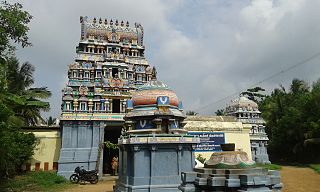
Thiruarimeya Vinnagaram or Kudamudakoothan Perumal Temple is dedicated to Hindu god Vishnu located in Tirunangur, a village in the outskirts of Sirkaḻi in the South Indian state of Tamil Nadu. Constructed in the Dravidian style of architecture, the temple is glorified in the Nalayira Divya Prabandham, the early medieval Tamil canon of the Alvar saints from the 6th–9th centuries CE. It is one of the 108 Divya Desams dedicated to Vishnu, who is worshipped as Kudamudakoothan and his consort Lakshmi as Amirtagadavalli.
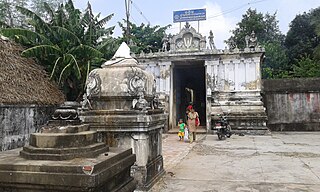
Thiruchsemponsey or Perarulaalan Perumal Temple is dedicated to Hindu god Vishnu located in Thirunangur, a village in the outskirts of Sirkazhi in the South Indian state of Tamil Nadu. Constructed in the Dravidian style of architecture, the temple is glorified in the Nalayira Divya Prabandham, the early medieval Tamil canon of the Alvar saints from the 6th–9th centuries AD. It is one of the 108 Divya Desam dedicated to Vishnu, who is worshipped as Peralulalan and his consort Lakshmi as Allimalar Nachiyar.

Thiruthevanartthogai or Madhava Perumal Temple is a Hindu temple dedicated to Vishnu located in Tirunangur, a village in the outskirts of Sirkaḻi in the South Indian state of Tamil Nadu. Constructed in the Dravidian style of architecture, the temple is glorified in the Nalayira Divya Prabandham, the early medieval Tamil canon of the Alvar saints from the 6th–9th centuries CE. It is one of the 108 Divya Desams dedicated to Vishnu, who is worshipped as Madhava Perumal and his consort Lakshmi as Kadalmagal.
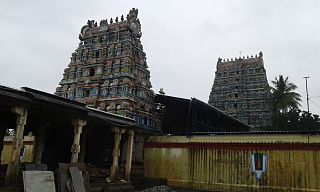
The Thiruvali - Thirunagari Temples are paired Hindu temples dedicated to Vishnu located 10 kilometres (6.2 mi) from Sirkali in Tamil Nadu, India, and 5 kilometres (3.1 mi) from each other. It is one of the Divya Desams, the 108 temples of Vishnu revered by the 12 poet saints, or Alvars. Unlike other Divya Desams where a single shrine is referred, this pair of temples is referred to together in all of the 41 pasurams (hymns). These temples follow the Tenkalai mode of worship.

The Gajendra Varadha Perumal Temple in Thirukkavithalam, a village in the outskirts of Papanasam in the South Indian state of Tamil Nadu, is dedicated to the Hindu god Vishnu. Constructed in the Dravidian style of architecture, the temple is glorified in the Nalayira Divya Prabandham, the early medieval Tamil canon of the Alvar saints from the 6th–9th centuries CE. It is one of the 108 Divya Desams dedicated to Vishnu, who is worshipped as Gajendra Varadha Perumal and his consort Lakshmi as Ramamanivalli. The temple is one of the five Pancha-Kannan temples, where Krishna, an avatar of Vishnu is given prominence over the presiding deity.

The Neelamegha Perumal Temple or Sowriraja Perumal Temple is a Hindu temple in Thirukannapuram, a village in the outskirts of Nagapattinam in the South Indian state of Tamil Nadu, is dedicated to the Hindu god Vishnu. Constructed in the Dravidian style of architecture, the temple is glorified in the Divya Prabandha, the early medieval Tamil canon of the Alvar saints from the 6th–9th centuries CE. It is one of the 108 Divya Desam dedicated to Vishnu, who is worshipped as Neelamegha Perumal and his consort Lakshmi as Thirukannapura Nayagi. As per Hindu legend, the presiding deity is believed to have appeared with a wig to save a devotee, leading to the name Sowriraja Perumal.

Thanjai Mamani Koil is a set of three adjacent Hindu temples dedicated to Vishnu located in Thanjavur, Tamil Nadu, India. It is one of the Divya Desams, the 108 temples of Vishnu revered by the 12 poet saints called the Alvars. Unlike other Divya Desams where a single shrine is referenced, this set of temples is referred together in all the pasurams.

The Thiru Aadanoor or the Andalakkum Aiyan Perumal Temple is a Hindu temple dedicated to Vishnu located in Aadanoor, Thanjavur district in Tamil Nadu, India. Constructed in Dravidian style of architecture, the temple is glorified in the Nalayira Divya Prabandham, the early medieval Tamil canon of the Alvar saints from the 6th–9th centuries CE. It is counted as one among the 108 Divya Desams dedicated to Vishnu. Vishnu is worshipped as Andalakkum Aiyan and his consort is worshipped as Ranganayaki, a form of Lakshmi.

The Thiruneermalai temple complex consists of two temples, the Ranganatha Temple and the Thiruneermalai Neervanna Perumal Temple. Both are Hindu temples in Thiruneermalai, a populated place in Kovur, a town in Chengalpattu district, Tamil Nadu, India.
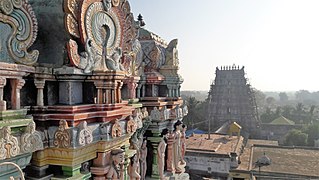
Sowmyanarayana Perumal Temple is an ancient temple located in Thirukoshtiyur, a village in the South Indian state of Tamil Nadu, dedicated to the Hindu god Vishnu. Constructed in the Dravidian style of architecture, the temple is glorified in the Nalayira Divya Prabandham, the early medieval Tamil canon of the Alvar saints from the 6th–9th centuries CE. It is one of the 108 Divya Desams dedicated to Vishnu, who is worshipped as Sowmyanarayana Perumal and his consort Lakshmi as Thirumamagal. The temple is known as the place where Ramanuja, the expounder of Vishishtadvaita philosophy preached the holy ashtakshara "Om Namo Narayanaya" to all people, irrespective of their varna.































